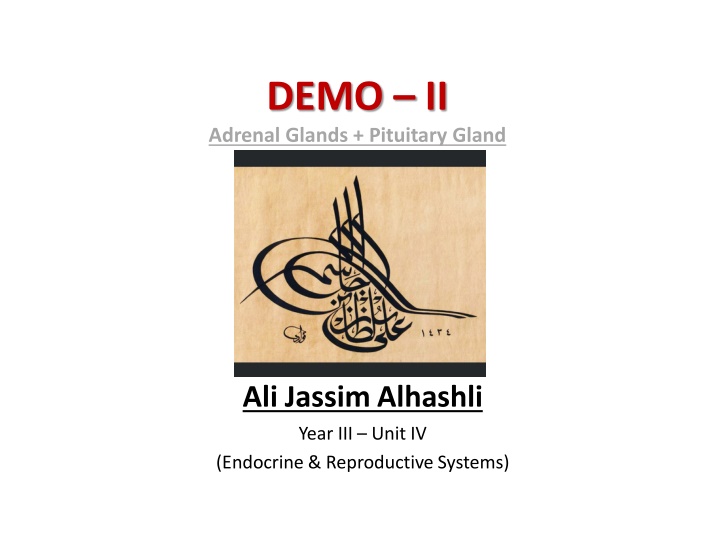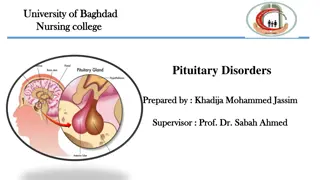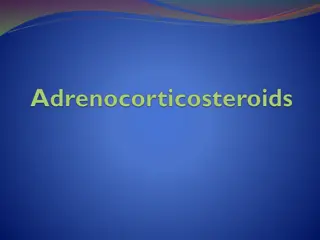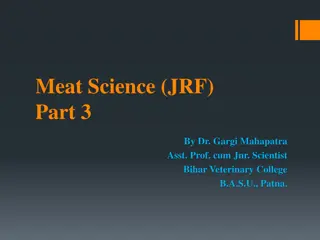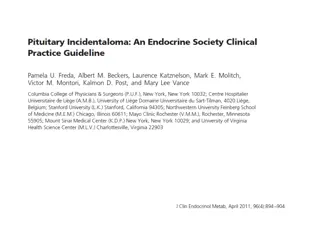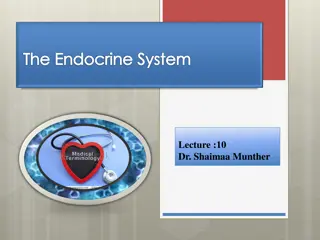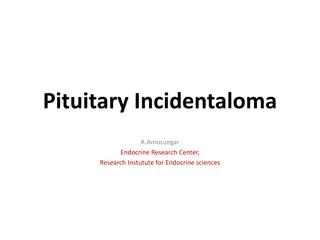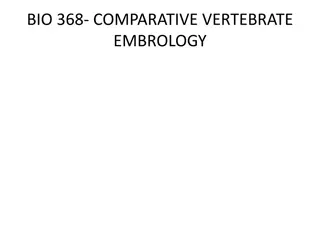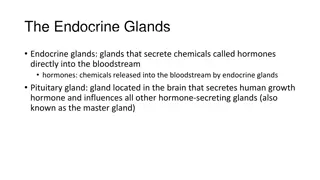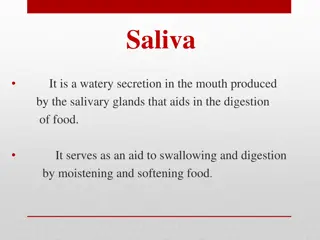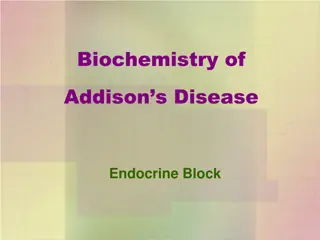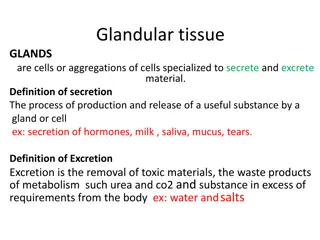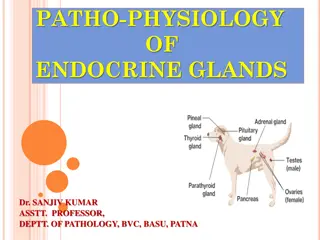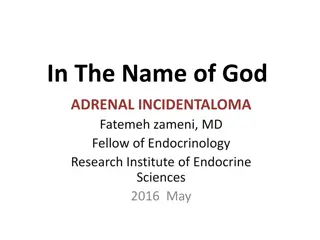Development of Adrenal and Pituitary Glands in Embryology
The adrenal glands consist of an outer cortex with three layers producing different hormones and an inner medulla containing chromaffin cells. Learn about the embryology of adrenal and pituitary glands, including the development process, layers formation, and associated tumors like pheochromocytoma. Explore how the adrenal and pituitary glands develop from neural crest cells and surface ectoderm, respectively, during embryonic stages.
Uploaded on Mar 07, 2025 | 1 Views
Download Presentation

Please find below an Image/Link to download the presentation.
The content on the website is provided AS IS for your information and personal use only. It may not be sold, licensed, or shared on other websites without obtaining consent from the author.If you encounter any issues during the download, it is possible that the publisher has removed the file from their server.
You are allowed to download the files provided on this website for personal or commercial use, subject to the condition that they are used lawfully. All files are the property of their respective owners.
The content on the website is provided AS IS for your information and personal use only. It may not be sold, licensed, or shared on other websites without obtaining consent from the author.
E N D
Presentation Transcript
DEMO II Adrenal Glands + Pituitary Gland Ali JassimAlhashli Year III Unit IV (Endocrine & Reproductive Systems)
STATION 1: Embryology of Adrenal Glands The adrenal glands consistof twoparts: - An outer cortex whichhas threelayers: Zona glomerulasa (producingmineralocorticoids). Zona fasciculata(producingglucocorticoids). Zona reticularis (producingandrogens). - An inner medulla (containing chromaffin cells which are post-ganglionic sympathetic neurons. These cells are columnar in shape and stain with potassium dichromate. They secret catecholeamines:epinephrine &NE). The development of adrenal glands with it stwo portions: - Neural crest cells some cells are going to descend between mesintary & urogenitalridge. - In this region, celomic mesothelium is formed during 4th 5thwk. - Which will then become the cortex during 6th 7thwk. -This cortex will engulf the sympathochromaffin cells which are derived from the neural crest cells (formingthemedulla). Note: - Atbirth:there are only two layersof the cortex (glomerulasa &fasciculata). - Atthe end of the 3rdyr: zona reticularis willappear. - Pheochromocytoma: is a tumor of the adrenal medulla secreting catecholeamines and resulting inhypertension.
STATION 1: Embryology of Pituitary Gland Embryology of the pituitary gland: - Anterior pituitary (adenohypophysis): developing from the surface ectoderm near the mouth (from the roof of the stomodeum by forming Rathke s pouch which if persists will result in craniopharyngioma). - Posterior pituitary (neurohypophysis): Proencephalon diencephalon posterior pituitary Mesencephalon. Rhombencephalon.
STATION 2: Pituitary Gland Anatomy Pituitary gland is in the middle cranial fossa (which is formed by the sphenoid bone that is butterfly- shaped) in the sellaturcica (specifically). Pituitary stalk (infundibulum): the connection between the hypothalamus and theneurohypophysis. Hypophyseal breaking down to capillaries no valves): releasing factors are secreted by transported to the anterior pituitary through this portal systemallowing the secretion of pituitary hormones. portal system (venous capillaries the hypothalamus and
STATION 2: Pituitary (x-ray) Tumor in thepituitary: - Might compress optic chiasma resulting in visual disturbances (bitemporal hemianopia) - Bursting into sphenoidbone. This sella turcica is enlarged
STATION 3: Adrenals Histology The adrenalgland
STATION 3: Adrenals Histology STATION - 3 *Producing (aldosterone mainly) under the influence of renin-angioten II system. * Arrangedinclumps. mineralocorticoid * Pale stainingbecause oflipids. *Producing glucocorticoids (cortisol). *Producingsomeandrogens. *Arrangedvertically. *Producing androgens. *Arrangedincords. *Containing (epinephrine & NE) which are synthesized from the amino acid tyrosine. catecholamines
STATION 3: Adrenals Histology Adrenal Medulla
STATION 3: Pituitary Histology Relations to the pituitarygland: 1. Superior: opticchiasma. 2. Inferior: sphenoid bone with sphenoidalsinus. 3. Lateral: cavernous sinuses 4. Posterior: mamillarybodies. Pituitary glanddivisions
STATION 3: Pituitary Histology (Adenohypophysis/Parsdistalis) Acidophils: secrete GH &prolactin. Basophils: secrete TSH, ACTH, LH,FSH Chromophobes: they stainpale
STATION 3: Pituitary histology (Neurohypophysis) Herring bodies contain neurosecretory products of the hypothalamic cells. Those areADH &oxytocin. Note: the neural cell bodies are in the hypothalamus and their axons extend to the posterior pituitary where the secretions accumulatein their terminals forming those herringbodies.
STATION 4: Adrenal Glands anatomy Location: - Located superiorly on each kidney - Posterior abdominal wall. - Right adrenal gland:pyramid. - Left adrenal gland:semi-lunar. - Posteriorly: the diaphragm for both right and left adrenal glands. Shape: Relations: - Anteriorly: * Right gland: inferior vena cava & right lobe of the liver. * Left gland: pancreas with its vessels, spleen & stomach+lesser sac. Arterial supply: - Superior suprarenal artery: from inferior phrenicartery. - Middle suprarenal artery: directly from the abdominal aorta. - Inferior suprarenal artery: from renal artery. Venous drainage: - Left gland: renal vein. - Right gland: inferior vena cava.
STATION 4: Pituitary Gland Anatomy Location: Divisions: -In sella turcica in the middle cranial fossa at the base of the brain. - Anterior pituitary (adenohypophysis): * Parstuberalis. * Parsintermedia. * Parsdistalis. - Posterior pituitary(neurohypophysis): * Parsnervosa. * Infundibulum (pituitarystalk). * Medianeminence. - Anterior & superior: optic chiasma. - Posterior: mamillarybodies. - Lateral: cavernous sinuses. - Inferior: sphenoid bone and sphenoidal sinus. Arterial supply (branches of internal carotid artery): - Superior pituitary artery: supplying pars tuberalis, infundibulum and median eminence. - Inferior pituitary artery: supplying the posterior pituitary gland. Venous drainage: to cavernous sinuses. Relations:
STATION 4: Pituitary gland anatomy The lateral aspects of the pituitary are adjacent to the cavernous sinuses. From superior to inferior, the cavernous sinus contains cranial nerves III (oculomotor), IV (trochlear), VI (abducens). These cranial nerves supply the muscles of the eye. V1 (ophthalmic branch of trigeminal nerve), and V2 (maxillary branch of trigeminal nerve). The internal carotid artery also courses through the cavernous sinus, medialto these nerves
GOOD LUCK! Wish You All The Best
